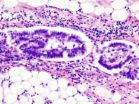(Press-News.org) SAN DIEGO — An extreme body mass index or high waist-to-hip ratio, both measures of body fat, increased risk for mortality among patients with breast cancer, but this association varied by race/ethnicity, according to recently presented data.
Marilyn L. Kwan, Ph.D., a research scientist in the Kaiser Permanente Northern California Division of Research in Oakland, Calif., presented these results at the Fifth AACR Conference on The Science of Cancer Health Disparities, held here Oct. 27-30, 2012.
Prior research has shown racial/ethnic differences in survival after a breast cancer diagnosis, particularly among non-Latina whites and African-Americans, according to Kwan. However, reasons for these differences in survival are not clear, and researchers have hypothesized that body size at the time of breast cancer diagnosis might play a role.
"The majority of studies among primarily non-Latina white populations on obesity before a diagnosis of breast cancer have found that increased weight is associated with poorer survival, yet few studies have examined if this association holds true within the major minority groups of African-Americans, Latinas and Asians and whether differences in obesity might explain racial/ethnic differences in survival," Kwan said.
She and her colleagues collected data from 12,025 female patients with breast cancer from the California Breast Cancer Survivorship Consortium. Body mass index (BMI) information was available for 11,351 women including 6,044 non-Latina whites, 1,886 African-Americans, 1,451 Asian-Americans, 1,864 Latinas and 106 others.
"Overall, we found that patients with breast cancer who were underweight, extremely obese or had high levels of abdominal body fat had the worst survival," Kwan said.
In fact, those women classified as underweight had a 47 percent increased risk for overall mortality compared with normal-weight women. Women classified as morbidly obese had a 43 percent increased risk for overall mortality. In addition, women with the highest waist-to-hip ratio (highest level of abdominal fat) had a 30 percent increased risk for overall mortality and a 36 percent increased risk for breast cancer mortality compared with those with the smallest waist-to-hip ratios.
When looking further at mortality within racial/ethnic groups, the researchers found that associations differed by race/ethnicity.
"Among non-Latina white women, being underweight and morbidly obese at breast cancer diagnosis was associated with worse survival, yet this relationship was not found in the other racial/ethnic groups," Kwan said. "Instead, African-American women and Asian-American women with larger waist-to-hip ratios had poorer survival, an observation not seen in non-Latina white women and Latina women."
Latina women had an elevated risk for mortality only among those considered morbidly obese.
According to Kwan, this study supports the common lifestyle recommendation to maintain a healthy weight throughout life, but she pointed out that the long-term impact of weight on survival after breast cancer might not be the same in all patients.
###
Follow the AACR on Twitter: @aacr #aacr
Follow the AACR on Facebook: http://www.facebook.com/aacr.org
About the American Association for Cancer Research
Founded in 1907, the American Association for Cancer Research (AACR) is the world's first and largest professional organization dedicated to advancing cancer research and its mission to prevent and cure cancer. AACR membership includes more than 34,000 laboratory, translational and clinical researchers; population scientists; other health care professionals; and cancer advocates residing in more than 90 countries. The AACR marshals the full spectrum of expertise of the cancer community to accelerate progress in the prevention, biology, diagnosis and treatment of cancer by annually convening more than 20 conferences and educational workshops, the largest of which is the AACR Annual Meeting with more than 17,000 attendees. In addition, the AACR publishes seven peer-reviewed scientific journals and a magazine for cancer survivors, patients and their caregivers. The AACR funds meritorious research directly as well as in cooperation with numerous cancer organizations. As the scientific partner of Stand Up To Cancer, the AACR provides expert peer review, grants administration and scientific oversight of team science and individual grants in cancer research that have the potential for near-term patient benefit. The AACR actively communicates with legislators and policymakers about the value of cancer research and related biomedical science in saving lives from cancer.
For more information about the AACR, visit www.AACR.org.
Body size and racial/ethnic differences in breast cancer survival. Marilyn L. Kwan1, Bette J. Caan1, Valerie S. Lee1, Esther M. John2, Scarlett Lin Gomez2, Salma Shariff-Marco2, Theresa H. Keegan2, Allison W. Kurian3, Leslie Bernstein4, Yani Lu4, Iona Cheng5, Kristine R. Monroe6, Richard Sposto6, Cheryl Vigen6, Anna H. Wu6. 1Division of Research, Kaiser Permanente Northern California, Oakland, CA, 2Cancer Prevention Institute of California, Fremont, CA, 3Stanford University School of Medicine, Stanford, CA, 4City of Hope, Duarte, CA, 5University of Hawaii, Honolulu, HI, 6University of Southern California, Los Angeles, CA.
Background: Studies of body size and breast cancer prognosis have primarily been conducted in non-Latina White women with little research to date in racial/ethnic minority groups. We investigated body size (body mass index [BMI], waist-hip-ratio [WHR], waist-height-ratio [WHtR], waist circumference [WC]) and survival by race/ethnicity (non-Latina White, African American, Asian American, and Latina) in the California Breast Cancer Survivorship Consortium (CBCSC).
Methods: The CBCSC represents 12,025 breast cancer patients diagnosed with primary invasive breast cancer from 1993-2007 from six California-based studies of breast cancer etiology or prognosis. Data on body size, race/ethnicity, and relevant covariates previously collected from in-person interview or mailed questionnaire were harmonized and pooled. Clinical characteristics and mortality information were obtained from the California Cancer Registry. Body size measures included minimum 6 months pre-diagnosis BMI in kg/m2 (underweight END
Associations linking weight to breast cancer survival vary by race/ethnicity
2012-10-29
ELSE PRESS RELEASES FROM THIS DATE:
Minorities most likely to have aggressive tumors, less likely to get radiation
2012-10-29
SAN DIEGO — Women with aggressive breast cancer were more likely to receive adjuvant chemotherapy, but at the expense of completing locoregional radiation therapy, according to recently presented data. This was especially true in minorities, who were the most likely to present with moderate- to high-grade and symptomatically detected tumors.
"Radiation treatment decreases the risk for breast cancer recurring and improves survival from the disease," said Abigail Silva, M.P.H., Susan G. Komen Cancer Disparities Research trainee at the University of Illinois in Chicago, ...
Language, immigration status of hispanic caregivers impacted care of children with cancer
2012-10-29
SAN DIEGO — Language barriers and the immigration status of caregivers appear to impact the care of Hispanic children with cancer and affect the experience of the families within the medical system, according to data presented at the Fifth AACR Conference on The Science of Cancer Health Disparities, held here Oct. 27-30, 2012.
"Ensuring good communication with patients and their families is as important as the actual therapy we give, regardless of what language is spoken," said Mark Fluchel, M.D., assistant professor in the department of pediatrics, division of hematology-oncology ...
Researchers look beyond space and time to cope with quantum theory
2012-10-29
Physicists have proposed an experiment that could force us to make a choice between extremes to describe the behaviour of the Universe.
The proposal comes from an international team of researchers from Switzerland, Belgium, Spain and Singapore, and is published today in Nature Physics. It is based on what the researchers call a 'hidden influence inequality'. This exposes how quantum predictions challenge our best understanding about the nature of space and time, Einstein's theory of relativity.
"We are interested in whether we can explain the funky phenomena we observe ...
NIH researchers identify novel genes that may drive rare, aggressive form of uterine cancer
2012-10-29
Researchers have identified several genes that are linked to one of the most lethal forms of uterine cancer, serous endometrial cancer. The researchers describe how three of the genes found in the study are frequently altered in the disease, suggesting that the genes drive the development of tumors. The findings appear in the Oct. 28, 2012, advance online issue of Nature Genetics. The team was led by researchers from the National Human Genome Research Institute (NHGRI), part of the National Institutes of Health.
Cancer of the uterine lining, or endometrium, is the most ...
Key discovered to how chemotherapy drug causes heart failure
2012-10-29
HOUSTON - Doxorubicin, a 50-year-old chemotherapy drug still in widespread use against a variety of cancers, has long been known to destroy heart tissue, as well as tumors, in some patients.
Scientists have identified an unexpected mechanism via the enzyme Top2b that drives the drug's attack on heart muscle, providing a new approach for identifying patients who can safely tolerate doxorubicin and for developing new drugs. A team led by scientists at The University of Texas MD Anderson Cancer Center reports its findings about the general DNA-damaging drug today in the ...
How to make stem cells – nuclear reprogramming moves a step forward
2012-10-29
The idea of taking a mature cell and removing its identity (nuclear reprogramming) so that it can then become any kind of cell, holds great promise for repairing damaged tissue or replacing bone marrow after chemotherapy. Hot on the heels of his recent Nobel prize Dr John B. Gurdon has published today in BioMed Central's open access journal Epigenetics & Chromatin research showing that histone H3.3 deposited by the histone-interacting protein HIRA is a key step in reverting nuclei to a pluripotent type, capable of being any one of many cell types.
All of an individual's ...
US shale gas drives up coal exports
2012-10-29
US CO2 emissions from domestic energy have declined by 8.6% since a peak in 2005, the equivalent of 1.4% per year.
However, the researchers warn that more than half of the recent emissions reductions in the power sector may be displaced overseas by the trade in coal.
Dr John Broderick, lead author on the report from the Tyndall Centre for Climate Change Research, comments: "Research papers and newspaper column inches have focussed on the relative emissions from coal and gas.
"However, it is the total quantity of CO2 from the energy system that matters to the climate. ...
Atrial fibrillation is a 'modifiable' risk factor for stroke
2012-10-29
Atrial fibrillation, whose prevalence continues to rise, was described last year as the "new epidemic" in cardiovascular disease, even though AF can be successfully controlled by the detection and management of risk factors, by rhythm control treatments, and by the use of antithrombotic therapies.(1) These therapies have been improved in the past few years by the introduction of new anticoagulant drugs, such that AF - like high blood pressure or smoking - may now be considered a "modifiable" risk factor for stroke, whose treatment can reduce the degree of risk.
Professor ...
Uncertainty of future South Pacific Island rainfall explained
2012-10-29
With greenhouse warming, rainfall in the South Pacific islands will depend on two competing effects – an increase due to overall warming and a decrease due to changes in atmospheric water transport – according to a study by an international team of scientists around Matthew Widlansky and Axel Timmermann at the International Pacific Research Center, University of Hawaii at Manoa. In the South Pacific, the study shows, these two effects sometimes cancel each other out, resulting in highly uncertain rainfall projections. Results of the study are published in the 28 October ...
Primates' brains make visual maps using triangular grids
2012-10-29
Primates' brains see the world through triangular grids, according to a new study published online Sunday in the journal Nature.
Scientists at Yerkes National Primate Research Center, Emory University, have identified grid cells, neurons that fire in repeating triangular patterns as the eyes explore visual scenes, in the brains of rhesus monkeys.
The finding has implications for understanding how humans form and remember mental maps of the world, as well as how neurodegenerative diseases such as Alzheimer's erode those abilities. This is the first time grid cells have ...



